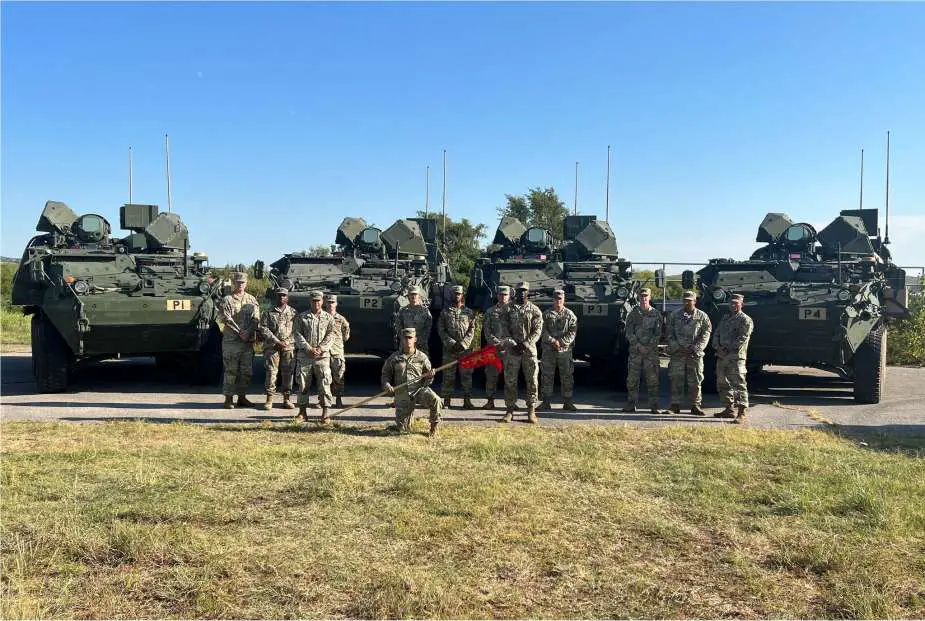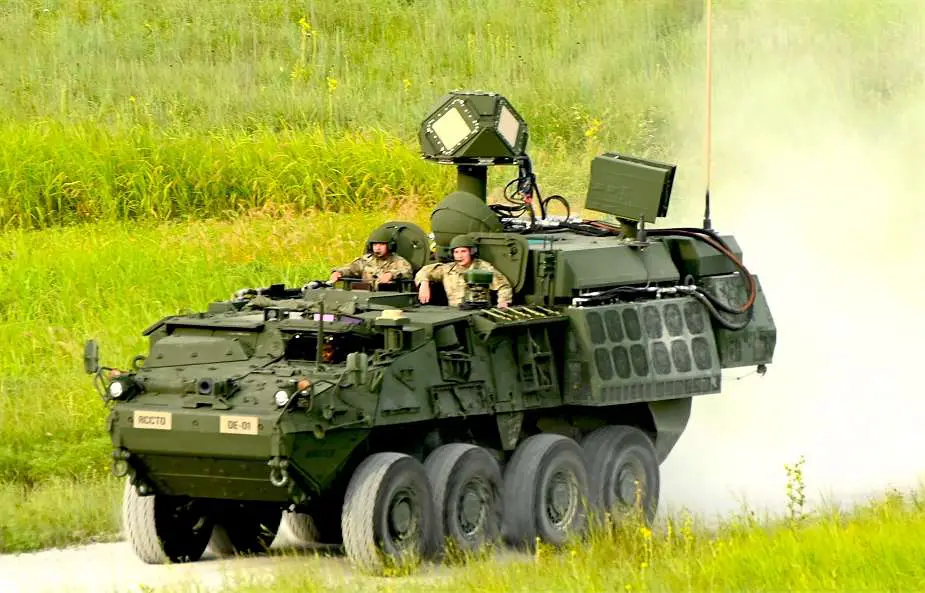US Army tests its new laser weapon vehicle DE M-SHORAD in real combat environments in Iraq
The U.S. Army has deployed its new Directed Energy Maneuver-Short Range Air Defense (DE M-SHORAD) systems in Iraq, as reported by "Defense News". These advanced laser weapon systems are being tested in real combat environments to assess their efficacy and operational readiness.
Follow Army Recognition on Google News at this link

U.S. soldiers of the 4th Battalion, 60th Air Defense Artillery Regiment are positioned alongside four Directed Energy Maneuver-Short Range Air Defense (DE M-SHORAD) prototype systems. (Picture source U.S. DoD)
The deployment includes three of the DE M-SHORAD laser-equipped combat vehicles, with a fourth slated to join them after undergoing further modifications, according to Lt. Gen. Robert Rasch, Director of the Army's Rapid Capabilities and Critical Technologies Office. This initiative is part of the U.S. Army's broader strategy to integrate 50-kilowatt laser platforms into its arsenal, aiming to enhance its defensive measures against aerial threats.
While the initial platoon-set of prototypes is operational in the U.S. Central Command's area of operations, the Army is simultaneously evaluating additional 50-kilowatt laser platforms. This dual-track approach underscores the Army's commitment to developing a robust air defense system that leverages the latest in directed energy technology.
The DE M-SHORAD (Directed Energy Maneuver-Short Range Air Defense) program is a cornerstone of the U.S. Army's strategy to significantly enhance its air defense capabilities in response to evolving aerial threats. Since 2005, the landscape of air and missile threats to U.S. ground forces has undergone a dramatic transformation. The proliferation of unmanned aerial systems (UASs) and their successful deployment in various conflicts, including the ongoing situation in Ukraine, has highlighted the urgent need for robust, mobile air defense solutions.
Recognizing the escalating threat and the limited air defense assets available to U.S. Army divisions, the Army embarked on an ambitious plan to augment the air defense posture of its maneuver forces. This initiative aimed to equip Army units with the capability to effectively counter a wide range of aerial threats, from drones to more traditional aircraft and missile threats.
As part of this strategic response, the U.S. Army planned to field 144 M-SHORAD Increment 1 systems across four battalions, with the possibility of expanding this capability to additional battalions in the future. Each M-SHORAD battalion was envisioned to comprise 40 M-SHORAD systems, accompanied by support vehicles, equipment, and approximately 550 soldiers, forming a formidable air defense network designed to protect maneuver forces.
The fielding process began in earnest in April 2021 when the 5th Battalion, 4th Air Defense Artillery Regiment, received the first batch of four M-SHORAD systems. This marked the beginning of a phased rollout, with the unit becoming fully equipped by late 2022. Beyond the systems designated for operational units, the Army also planned to procure an additional 18 systems. These extra systems were intended for training purposes, operational spares, and testing, bringing the total number of systems to 162.
This comprehensive procurement and fielding plan underscored the Army's commitment to addressing the heightened aerial threats and ensuring the protection of its ground forces through advanced air defense systems. The DE M-SHORAD program, with its integration of 50-kilowatt class high-energy laser weapon systems onto Stryker A1 8x8 armored vehicles, is a pivotal element of this strategy. The program's rapid progress from concept to deployment, culminating in the operational testing of prototypes in late 2022, reflects a significant achievement in the Army's modernization efforts and its ongoing endeavor to maintain technological superiority in air and missile defense.

The U.S. Army De M-SHORAD is a new laser weapon combat vehicle based on the Stryker 8x8 armored vehicle armed with one 50-kilowatt class high-energy laser weapon system. (Picture source U.S. DoD)
The DE M-SHORAD (Directed Energy Maneuver-Short Range Air Defense) vehicle integrates a formidable 50-kilowatt class high-energy laser weapon system onto the platform of a Stryker A1 8x8 armored vehicle, representing a cutting-edge air defense solution designed by the U.S. Army. This innovative combination aims to enhance the Army's capability to counter a variety of aerial threats, including unmanned aerial systems, rotary and fixed-wing aircraft, and indirect fire weapons like rockets, artillery, and mortars.
The laser weapon system itself is a pinnacle of precision and lethality. By harnessing the power of directed energy, it offers a significant advantage in terms of speed, precision, and cost efficiency. The laser is capable of engaging and neutralizing threats at the speed of light, providing a nearly instantaneous response to emerging threats. This rapid engagement capability is critical in high-threat environments where the speed of response can determine the outcome of an encounter.
Furthermore, the system's precision minimizes collateral damage, making it suitable for operations in varied environments, including populated areas where the risk to civilians is a concern. The operational cost per engagement is also lower compared to traditional kinetic weapons, as the system relies on electrical power.
Mobility is another key aspect of the DE M-SHORAD vehicle. Built on the Stryker A1 platform, the vehicle benefits from the Stryker family's proven mobility, survivability, and versatility. The Stryker A1 variant includes upgrades such as the Double-V Hull (DVH), which offers enhanced protection against mines and improvised explosive devices. The vehicle's 8x8 wheel configuration provides excellent mobility across a variety of terrains, ensuring that the DE M-SHORAD can be rapidly repositioned as operational needs dictate. This mobility allows the DE M-SHORAD to keep pace with maneuver forces, providing close-in protection and enhancing the overall survivability of the force.
Defense News April 2024
- Hits: 7397
















